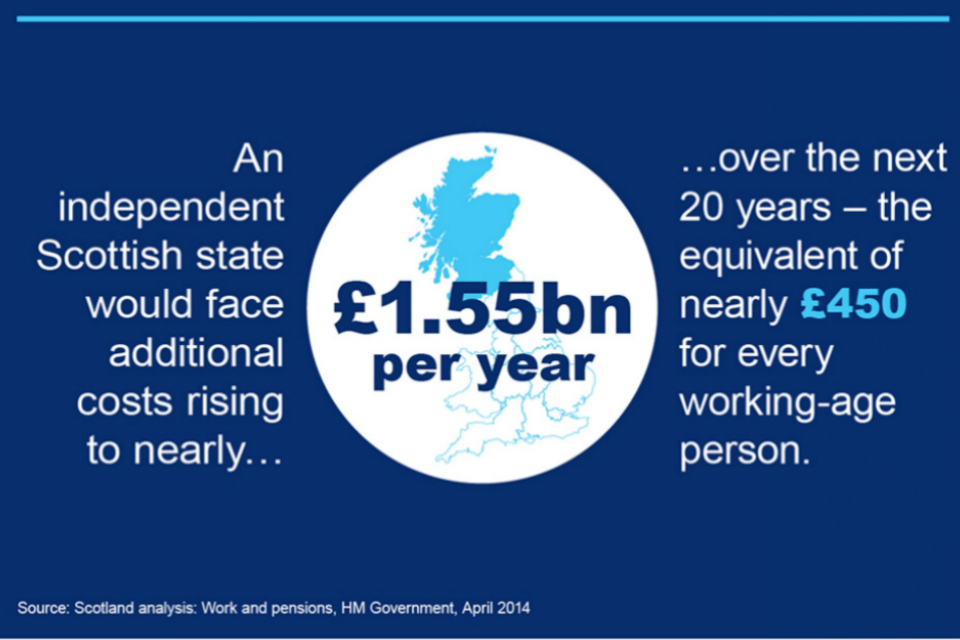Work and pensions - summary leaflet
Published 1 May 2014
Work and Pensions
2.8 million people in Scotland receive some form of social security benefit or tax credit. DWP’s operating costs in Scotland: around £720 million per year.
People who live and work in Scotland – and the employers who operate there – benefit from being part of a UK-wide labour market.
Scotland is better placed as part of the more diverse UK economy to address the future demographic challenges it faces. These challenges, and Scottish Government spending commitments, mean independence would result in an increased cost of £450 per working-age person per year over the next 20 years.

A UK-wide social security system and labour market works well for Scotland
-
Scotland benefits from the UK’s flexible labour market, a resilient, pan-UK social security system, and additional spending per head on social security - At £3,335 per person annually, this is nearly 2% higher than the rest of the UK, and has previously been up to 9% higher
-
Workers can easily move throughout the UK, helping to match individuals and jobs, and to alleviate unemployment in particular areas in times of economic difficulty. Individuals have access to a Great Britain-wide network of job centres
-
Scotland has an unemployment rate of 6.5%, which compares favourably with the UK average of 6.9%. Scotland has recently seen record numbers of women in work
In future, cost pressures are forecast to increase and those are better absorbed by the bigger, more diverse UK economy than that of an independent Scottish state
-
The UK, like other countries across the Western world, is facing a demographic challenge, due to the increase in the number of people of pension age. An independent Scotland is facing a more acute challenge than the UK as a whole, both in terms of demographic change and the ability to absorb the impact from a narrower tax base
-
The current Scottish Government has said an independent Scotland would reverse some UK policies, but not how it would pay for them. Not increasing the state pension age to 67, for example, would cost around £6billion between 2026/27 and 2035/36 in extra pension costs and around £9billion in lost GDP
-
Taken together, a combination of demographic changes and spending commitments means spending rising to nearly £1.55 billion more per year over the next 20 years in today’s terms, than if spending per working-age person was at average UK-levels. This results in an increased cost of around £450 per working-age person per year in Scotland over the next 20 years
The unpicking of an integrated infrastructure to pay benefits and pensions would be complex and the development and set-up of new systems would incur costs. Running costs could also increase given the loss of economies of scale
-
Every day DWP makes around 258,000 benefit payments and processes nearly 4,000 new claims to benefit in Scotland. Over half the Scottish population (2.8 million people) receive some form of social security
-
The Scottish Government would face significant costs in setting-up and running its own benefit system. DWP’s annual operating costs for Scotland are £720 million (9.8% of DWP operating costs), which would increase under independence due to loss of economies of scale. One-off set up costs would also be £millions, e.g. one-off IT costs could be between £300-400 million
-
The Scottish Government has indicated that, in the event of independence, it may seek to continue to use the UK’s systems for a transitional period. This would be subject to negotiation with the UK Government. The Scottish Government would, however, not be able to share IT systems and services if they plan to make changes to current UK social security policies, which would introduce additional costs and risks to the UK Government
